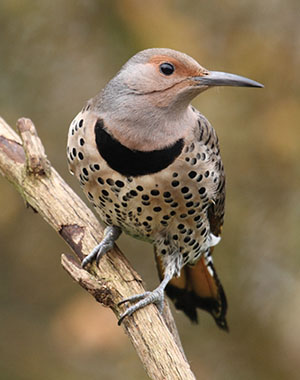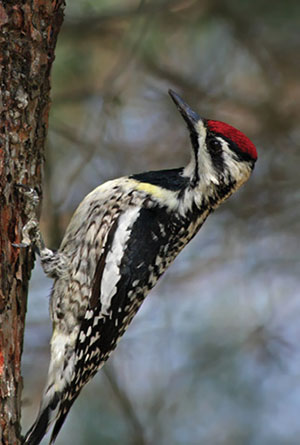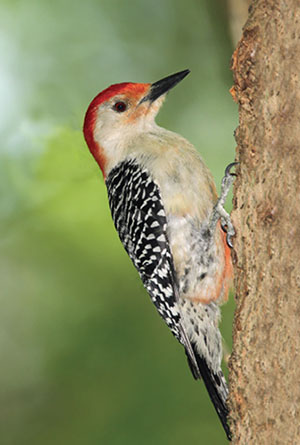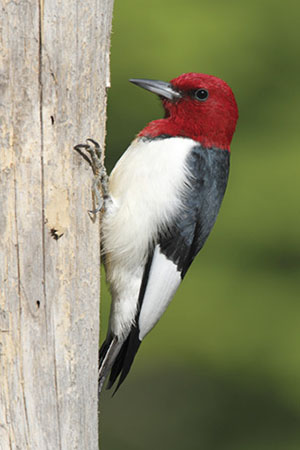Guide L-211
Revised by Samuel T. Smallidge
College of Agricultural, Consumer and Environmental Sciences, New Mexico State University
Author: Extension Wildlife Specialist, Department of Extension Animal Sciences and Natural Resources, New Mexico State University. (Print Friendly PDF)
Introduction
Several species of woodpeckers, flickers, and sapsuckers live in a variety of habitats throughout New Mexico. Under most circumstances, they are beneficial to the natural environment. However, their hammering or drumming on buildings and other structures may cause significant damage.
Most damage from woodpeckers in New Mexico occurs in urban and suburban areas. Spring is generally the worst season, corresponding to the breeding season and territory establishment. However, woodpecker damage can occur throughout the year. The northern flicker, yellow-bellied sapsucker, red-bellied woodpecker, and red-headed woodpecker are the most common species that create damage in New Mexico.
Drumming is the term used to describe the rapid pecking woodpeckers make on hard surfaces. In the spring, they drum to establish territories and to attract mates. Metal items, such as gutters, drain spouts, street lights, and TV antennas, may be chosen for drumming sites. Although metal surfaces are seldom damaged, the noise can be frustrating. When woodpeckers drum on structures, such as wooden siding, eaves, trim boards, or stucco, damage may be extensive.
Extensive damage can also occur when woodpeckers create holes while searching for insects or excavating nesting cavities. These holes can be round and smooth or vertical, rough gashes that are one to several inches long. Woodpeckers—particularly sapsuckers—may damage ornamental and fruit trees.
Biology And Identification
Woodpeckers generally prefer snags or partially dead trees for nesting sites. They can also be seen readily pecking holes in trees and wooden structures in search of various insects, including spiders and ants. While many woodpecker species feed primarily on insects, some also eat berries, fruits, nuts, seeds, and sap. For example, sapsuckers eat sap they obtain by pecking rows of small holes through the bark of live trees.
Woodpeckers, flickers, and sapsuckers are 5 to 15 inches long. Their stout, sharply pointed beaks are well-adapted for pecking into wood in search of insects and to chisel out nesting cavities. They have relatively short legs and usually four toes with sharp claws. Two of the toes point forward while the other two point backward, forming an X shape, which allows them to cling to tree trunks and branches. They also have stiff tail feathers, which they use to brace themselves against the tree. Woodpeckers generally fly with a series of rapid wing flaps followed by short glides with the wings folded against the body.
Woodpeckers breed in the spring and commonly lay three to six eggs. The incubation period generally lasts for only 11 to 14 days. Many woodpeckers have two broods per year, but some species may have three.
Northern flicker
The northern flicker (Colaptes auratus) is also commonly called the common flicker, red-shafted flicker, or yellow-shafted flicker. Yellow-shafted flickers have yellow coloration on the undersides of their wings and tail feathers, while red-shafted flickers have salmon-red coloration in these areas. The northern flicker is about the size of a pigeon with a brown back and dark bars and spots (Figure 1). The head is gray with a brown crown. The male also has a distinct red mustache stripe. In flight, its white rump and yellow- or salmon-colored underwings and tail show.
Figure 1. Northern flicker (Teekaygee, Dreamstime.com).
Yellow-bellied sapsucker
The yellow-bellied sapsucker (Sphyrapicus varius) is about 8 1/2 inches long with a red forehead patch and a long, white wing patch (Figure 2). The male has a patch of red on its throat, while the female has only a partly red to white throat.
Figure 2. Yellow-bellied sapsucker (Mircea Costina, Dreamstime.com).
Red-bellied woodpecker
The red-bellied woodpecker (Melanerpes carolinus) is about the same size as a robin. Its back and upper wings are barred with black and white feathers, giving a “ladder back” appearance (Figure 3). The male has red feathers on the top of its head and back of its neck. The female has red feathers only on the back of its neck.
Figure 3. Red-bellied woodpecker (Brian Lasenby, Dreamstime.com).
Red-headed woodpecker
The red-headed woodpecker (Melanerpes erythrocephalus) is about 10 inches long, and its entire head is red (Figure 4). Its wings and tail are bluish black, and it has a large, white patch on each wing. It also has a white rump, which is evident when flying.
Figure 4. Red-headed woodpecker (Brian Lasenby, Dreamstime.com).
Damage Prevention And Control Methods
Woodpeckers can be extremely persistent and are not easily driven from their territories or drumming sites. Therefore, damage prevention and control methods must be implemented immediately after woodpeckers begin creating damage. A combination of control methods may also be needed to control woodpeckers successfully.
Restrictions
Woodpeckers are listed as migratory, nongame birds and are protected by state and federal laws. Permits must be obtained from the U.S. Fish and Wildlife Service before live trapping or killing of woodpeckers is attempted. There must be good justification for the issuance of a permit. Contact the Migratory Bird Office of the U.S. Fish and Wildlife Service in Albuquerque at (505) 248-7882 or PermitsR2MB@fws.gov.
Habitat modification
In some cases, eliminating foods that attract woodpeckers to areas near buildings, such as suet at bird feeders, may be helpful. Dead trees can also harbor insects that attract woodpeckers and may therefore need to be removed. However, removing such trees may deny woodpeckers their drumming, nesting, or food sites, forcing them to use the building instead. In fact, allowing large dead limbs to remain on trees has, in some cases, reduced damage to buildings.
Deterrents
Sometimes, visual and auditory deterrents may dissuade woodpeckers from drumming if used soon after the damage begins. Hawk or falcon silhouettes can be constructed from plywood, cardboard, or construction paper (Figure 5); painted black; and hung from the eaves of the building near the damage sites. A 1-foot piece of monofilament fishing line can be attached to the silhouette at the beak, using a fishing swivel, and hung near the drumming site. This allows the silhouette to move freely in the breeze. Two silhouettes used at one drumming site sometimes provide better results. Moving the location of the silhouettes daily also helps prevent the woodpecker from becoming too familiar with them. Owl silhouettes, owl decoys, rubber snakes, and cat silhouettes are generally ineffective.
Figure 5. Hawk or falcon silhouette (Texas Wildlife Damage Management Service, 1998).
Aluminum foil strips or brightly colored plastic strips 1 to 3 inches wide and 2 to 3 feet long can be attached to a 6-inch-long string and hung above the drumming site. Mylar tape with two reflective sides is available commercially for use as a bird deterrent. Attach the strips so that they hang freely and move with every breeze.
Sound also can be used to harass nuisance woodpeckers. Loud noises from clapping hands, shooting a toy cap pistol, playing a radio, or banging pans may frighten the woodpeckers from the area. However, auditory repellents must be used persistently to be effective.
Water sprinklers sometimes prevent woodpeckers from damaging buildings. Direct a water stream at the area the woodpecker is damaging. The sprinkler can be turned on whenever the bird begins drumming and left on until it leaves.
Taste or odor repellents are generally ineffective. Sticky or tacky bird repellents, such as Bird Tanglefoot and 4-The-Birds, applied in the damaged area and for several feet on either side have been effective in some cases. Birds do not get trapped in the sticky or tacky repellents, but they dislike the tacky footing. Smearing the tacky bird repellents on limbs or trunks where sapsuckers are causing damage can sometimes discourage the birds away from high-value ornamental trees. The same types of repellents can also be applied to damaged areas on wood or stucco siding. However, some sticky bird repellents will discolor the material to which they are applied. During warm weather, they may run and leave streaks. Because the repellents may stain, they should be applied to masking tape and not directly on the surface to be treated.
It is important to remember that in many cases deterrents and repellents only provide temporary protection. Therefore, exclusion practices must be used to provide long-lasting nuisance woodpecker control.
Exclusion
One of the most effective ways to exclude woodpeckers from damaging wood or stucco siding beneath the eaves is to use plastic or nylon netting. Netting (3/4-inch mesh) can be attached to the overhanging eaves and angled back to the siding below the drumming site. Make sure that the netting is taut, and leave at least 3 inches of space between the netting and the building (Figure 6).
Figure 6. Plastic netting used to exclude woodpeckers from eaves. The inset shows one attachment method that uses hooks and wooden dowels (Texas Wildlife Damage Management Service, 1998).
Metal sheathing or 1/4-inch hardware cloth can be placed over pecked areas on buildings to provide permanent protection from continued damage. However, sometimes the birds will move to an unprotected spot, and the protected area will have to be expanded.
Ornamental and fruit trees can be protected by covering the damaged areas with 1/4-inch hardware cloth, plastic mesh, or burlap. Draping plastic or nylon netting over the entire tree will also provide protection from woodpecker damage.
Trapping
It may be necessary to kill the birds if nonlethal methods are unsuccessful (see Restrictions section in this guide). The federal permit will explain whether trapping and/or shooting are allowed.
Nailing wooden rat snap traps to the damaged area can be effective for killing the offending birds. The trap should be secured to the building with the trigger placed down along the damaged area. Make certain the traps are out of reach of children and pets. Baits include walnuts, almonds, pecans, or suet.
Shooting offending woodpeckers with air rifles or .22-caliber rifles with dust shot or BB caps can be effective. Be sure to check with local authorities on the use of firearms. Discharging firearms near residential structures is illegal in many areas. Good judgment must be used if lethal measures are employed.
Other control methods
Placing suet stations near damaged buildings will occasionally entice woodpeckers away. However, do not offer suet during the warmer seasons because it may be harmful to woodpeckers. The suet can get on the bird’s feathers and may lead to matting and eventual feather loss.
Some success has been achieved by placing cavity-type nest boxes near the damaged area on the building or on trees near the building for woodpeckers, especially northern flickers (Figure 7). Nest boxes are constructed of wood, and should be about 6 by 6 inches in width and about 22 to 26 inches in height. Add an entrance hole about 2 1/2 inches in diameter and 16 to 20 inches above the floor. A thick layer of sawdust should be placed in the bottom of the nest box. Be aware, however, that woodpeckers may construct new cavities next to the nest box.
Figure 7. Nest box used to reduce damage by woodpeckers (Lee and Henderson, 1992).
Acknowledgments
Much of the information in this publication was adapted from the following sources.
Lee, C., and F.R. Henderson. 1992. Woodpeckers, urban wildlife damage control [L-866]. Manhattan: Kansas State University, Cooperative Extension Service.
Marsh, R.E. 1994. Woodpeckers. In S.E. Hygnstrom, R.M. Timm, and G.E. Larson (Eds.), Prevention and control of wildlife damage (pp. E-139–E-145). Lincoln: Great Plains Agricultural Council, University of Nebraska.
Texas Wildlife Damage Management Service. 1998. Wildlife damage management: Controlling woodpecker damage [L-1922]. San Antonio: Texas Wildlife Damage Management Service.
For Further Reading
L-210: Rabbits and Their Control in New Mexico
https://pubs.nmsu.edu/_l/L210/index.html
L-212: Controlling Nuisance Birds in New Mexico
https://pubs.nmsu.edu/_l/L212/index.html
CR-574: Controlling Rock Squirrel Damage in New Mexico
https://pubs.nmsu.edu/_circulars/CR574/index.html
Brand names appearing in publications are for product identification purposes only. No endorsement is intended, nor is criticism implied of similar products not mentioned. Persons using such products assume responsibility for their use in accordance with current label directions of the manufacturer.
Original authors: Jon Boren, Extension Wildlife Specialist; and Brian J. Hurd, Extension Research Specialist.

Samuel T. Smallidge is the Extension Wildlife Specialist at New Mexico State University. He has degrees in wildlife and range management. His Extension program focuses on wildlife damage management, wildlife enterprises, and wildlife ecology and management education for youth and adults.
To find more resources for your business, home, or family, visit the College of Agricultural, Consumer and Environmental Sciences on the World Wide Web at pubs.nmsu.edu.
Contents of publications may be freely reproduced for educational purposes. All other rights reserved. For permission to use publications for other purposes, contact pubs@nmsu.edu or the authors listed on the publication.
New Mexico State University is an equal opportunity/affirmative action employer and educator. NMSU and the U.S. Department of Agriculture cooperating.
Revised December 2022 Las Cruces, NM









